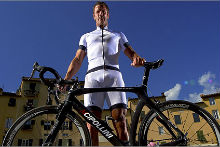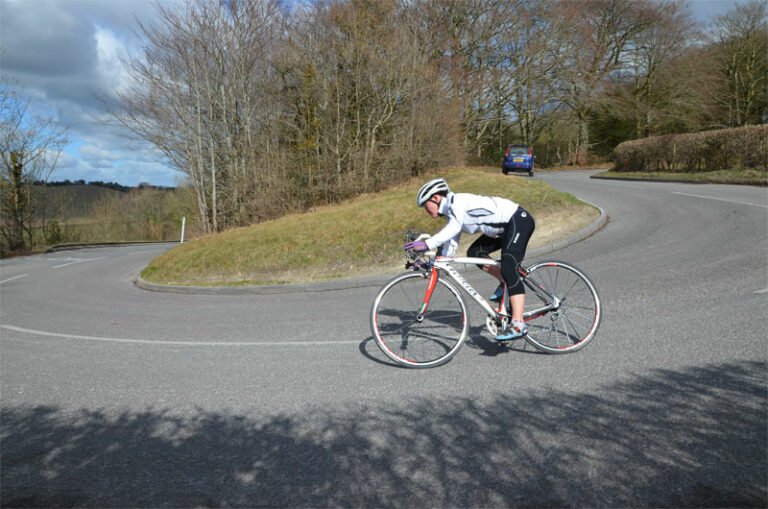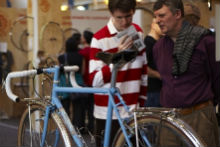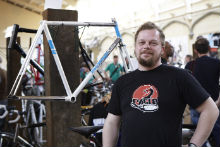For many riders taking on their first sportive next month, beginning their challenge with hundreds of other riders represent their first experience of riding in a bunch.
The dynamics of bunch riding can seem daunting, but by following a few simple tips, you can proceed smoothly and enjoy the considerable aerodynamic benefits of shelter in a large group of riders.
We asked two leading coaches for their tips on how best to face the challenge of riding in a large bunch. Dave Lloyd was one of Britain’s top riders before becoming a coach, a member of the legendary TI-Raleigh team of the 1970s and early 1980s. Marc Laithwaite is qualified at level three with the Association of British Cycle Coaches, and holds an honours degree in sports science.
Acquiring any new skill usually involves overcoming a few fundamental errors that mark the novice from more experienced practitioners. Bunch riding is no different. For Lloyd, a failure to relax identifies the novice bunch rider. “You see white knuckles on the tops of the bars,” he says. “Rather than moving the wheel slightly to one side of the person in front, they ride ‘under’ the wheel,” he adds, a tendency that can lead to danger if the rider in front brakes or rises from the saddle on a climb. Laithwaite identifies a misplaced desire to impress. “They push the pace too early and think they are hurting people by sitting on the front of the group and riding as hard as possible,” he says. “It’s not group etiquette and everyone else will simply sit in their slipstream and allow them to tire themselves out.”
To many sportive newcomers, the sensation of riding with others will not be entirely alien, simply on a greater scale and with strangers. The experience of riding with a large group of new riders can be far removed from the cosy dynamic of regular training rides with the same small group of friends. Laithwaite urges awareness: “You may have a specific way of riding with friends which may not be the case when riding in a larger group so watch and learn.”
Lloyd also identifies spatial awareness as “the biggest thing” and highlights the constantly changing nature of a bunch of riders. “The bunch is very dynamic. Things will move in front of you. Move in the bunch. That was one of the first things I learned when I moved from riding in small bunches of 50 or 60 people to bunches of 300 or so in training races in the south of France. It’s just getting used to what’s going on around you,” he says.
“You have got to pre-empt things rather than waiting until something happens. Don’t get swamped. Don’t get to the back where you’ll have to move to the side and into the wind to move back to the front.”
With hundreds of riders jostling for a starting position and many poised to begin a challenge for which they will have spent several months preparing, the start line of a sportive can be an intense environment, despite the emphasis on personal challenge rather than competition. As the event gets underway, the temptation to ride too hard and too fast can be difficult to resist.
“Don’t get carried away with the moment and let the adrenalin take over. There’s a lot of adrenalin flying around at the start of a sportive,” cautions Lloyd. “You have to remember that some sportives can be very long. The Marmotte, for example, is long and hilly. You have to save energy for the last hill. It’s about staying out of the wind and saving energy. You have got to have control. If you’re not going as fast as the guys in front, ride where you’re comfortable,” he says.
Laithwaite also recommends a calm approach and concentrating on the scale of the task in hand. “Going too hard in the opening miles is an absolute killer,” he warns. “You should complete the first couple of hours and feel that you are still very fresh. To do this you either need to ride alone at an easy pace or preferably sit in a decent group and get towed along. You should also make sure you are feeding and drinking with the last two hours in mind.”
Both are agreed on the aerodynamic benefits of riding in a group and sheltering from the wind. Lloyd estimates the energy saved from riding in the wheel of another rider at 40 per cent. Laithwaite describes the benefits of bunch riding in more emphatically: “Huge.”
“Make the most of it,” he adds. “Many riders often feel that they are not going quick enough because it feels so easy and with adrenaline pumping, they try to push on ahead. Relax, enjoy the free ride and be safe in the knowledge that the last few hours will be hard and you’ll need the energy.”
Communicating with other riders is essential if collisions are to be avoided – a skill not required in the training group, where trust develops over time and understandings are often unspoken. Lloyd says there are no “hard and fast” rules for communicating in a bunch, some signs are universal. “People will point to the left for parked cars, or down for a pot hole. It’s the etiquette of the bunch,” he says. Laithwaite agrees and calls on riders to be accountable in a common responsibility among all members of the bunch. “Tell them what’s happening and warn them about pot holes etc. You are responsible for all other members in the group and your actions impact on everyone. Use common hand signals where appropriate but other than that, shout clearly rather than surprising them!” he says.
Positioning yourself in the bunch is a matter of judgment that improves with experience. “If you’re right at the back, the concertina effect caused by braking hits you last and has a bigger impact. If there’s 20 in the group, place yourself in sixth to eighth position,” says Laithwaite.
Lloyd calls for a pre-emptive approach, awareness of what’s going on around you, concentration, and confidence to respond to the constantly shifting dynamic.
“You have to make space for yourself and pre-empt things. Give yourself room. Don’t be frightened or intimidated. If there’s a gap, and you feel you can get through it, go through it. If they are going backwards, most will show common sense and keep to the side of the road. You have to concentrate. Don’t be distracted. People shout and scream from the side of the road and while you’re looking, someone may brake in front of you,” he warns.





